Disclosure: Please note that some links are affiliate links, and at no additional cost to you, we earn a commission if you make a purchase.
If you would like to support this website in some way, using these links will help do exactly that.
There are different methods of transportation that we have used in Germany over the years. We have boarded airplanes, rented cars and traveled by train. My favorite way to get around? That would be train travel and here are four reasons why I tend to choose spending hours on a train instead of another mode of transportation.
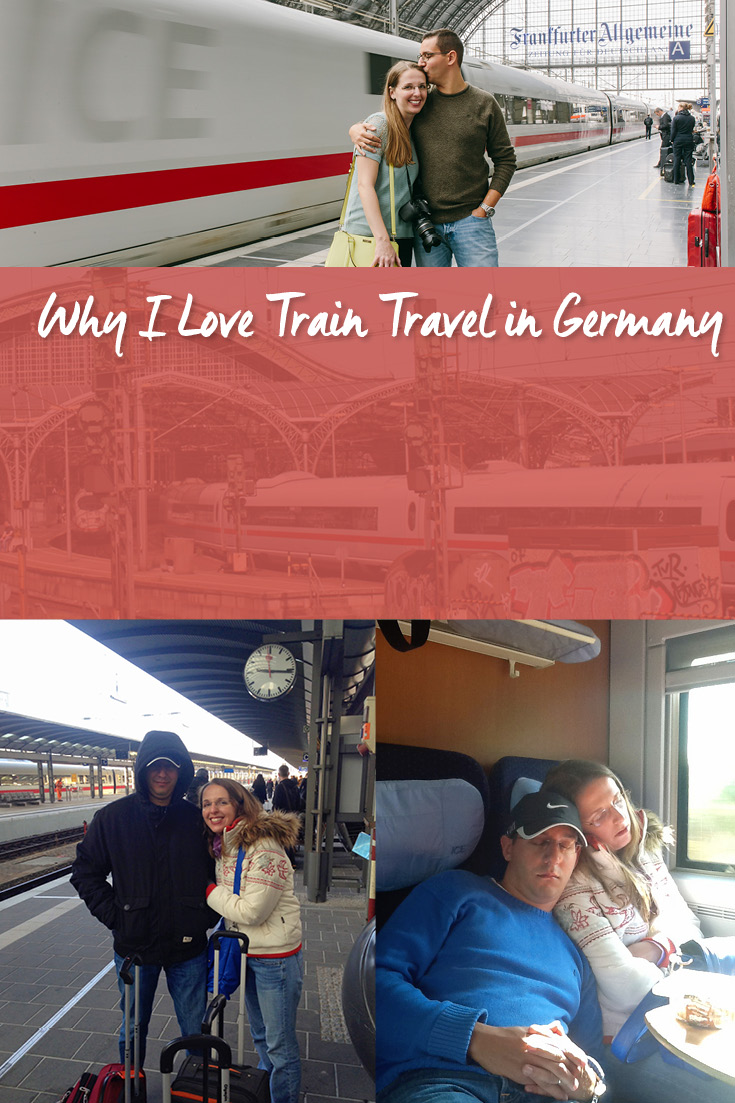
Reason #1 See More of the German Countryside
All trains have large windows where you can enjoy the landscape as it flies by (especially in the ICE high speed trains). You will see rivers, mountains, and small villages - all of which you miss when you fly or take the car on the Autobahn. Of course you can take rural roads with a rental car, but it will be slower and the driver will have to watch traffic much more than any landscape surrounding the car.
Board the train, find your seat, get comfortable and enjoy whatever you like to do. If looking out the window is not your thing, you can read, listen to music, or sleep a bit. Lots of high-speed trains have free Wifi (https://www.bahn.com/en/view/trains/on-board-service/wifi.shtml) and outlets to charge your devices and stay in contact with your family and friends back home. Just don’t get too distracted and miss your destination while enjoying the comfort of the train.
Reason #2 No Luggage Restrictions
Bringing any kind of luggage onto an airplane these days, usually results in a fee you have to pay. This means extra income for the airlines and customers are willing to pay anywhere from $20 to $75 for this convenience. Not so on the train (or your rental car, of course). Bring as many pieces of luggage as you want, or are able to pull along with you. Even pack liquids and something to drink inside the train. No one will take it away from you.
Denise and I usually share a larger suitcase instead of two smaller ones. Most long distance trains have an extra area between seats where you can store your luggage. Otherwise you can lift it onto the rack above the seats, just make sure it is not too heavy and falls on your head.
Reason #3 Less Expensive
When comparing plane tickets or car rental prices to a train ticket, the train ticket is often your least expensive option, especially when you buy your ticket in advance and factor in the hidden costs. The airline might charge you extra for your luggage, even if it is just a carry on bag. And you better buy a preferred seating position with that, so you board the plane while overhead space for your carry-on is still available.
The same goes for the rental car option, which will have you paying for fuel costs and parking, not to mention all the extra insurance fees they try to add when you pick up your car. If you want to know more about this, read our earlier article, What to Consider When Renting a Car in Germany.
The best way to get your hands on an inexpensive train ticket in Germany (usually half-off) is to book 70-90 days before your trip on the website of the Deutsche Bahn.
You can get tickets for as low as 29 € per person for long trips, but ticket prices go up as the departure date draws near, so plan accordingly, and buy early. Denise and I will create a calendar event exactly 90 days before in order to get the best train ticket price. When its time to buy, simply enter your destination, date and approximate time on the Deutsche Bahn website and you will be given a range of options to choose from. When reserving your train ticket, you pick your favorite connection and have the option to purchase reserved seating for about 5 € per person/train. There are no other fees added on after you check out. I highly recommend purchasing a seat, especially if you are on the train for several hours or travel with a larger group of people.
You will also see that some connections will be faster, some slower. Here is a ranking from fastest to slowest trains:
• ICE (Inter City Express) usually pronounced ‘Eye See Eee’, are the fastest German trains
• IC (Inter City) trains are a bit slower than ICE trains with a few more stops along the way
• RB (Regional Bahn) and RE (Regional Express) tend to be highly localized with lots of stops. You will see more of the countryside, on IC/RB/RE trains, but travel time can be up to double compared to an ICE train.
Reason #4 Simply, Faster
In Germany you might overhear someone saying, that the train is “late, again”. Some trains are notorious for running late and Germans, always punctual, are notorious for complaining about this fact. However, I still believe taking a train is the fastest option, and here is why. A train ride from Frankfurt to Paris, France will take about 4 hours. A car ride will take 5 ½ hours, if there is “normal” traffic on the Autobahn 4 from Frankfurt to Paris. It takes longer due to the lower speed limit in France, which is 130 km/h (80 mph). A train can go as fast as the tracks will let it and reaches speeds up to 200 mph on some track parts.
So driving can’t compete with taking the train, which leaves us with flying. A plane ride from Frankfurt to Paris takes only 1 hour 10 minutes. However, if you add transportation time to the airport (most are not in the city center, unlike train stations) and being there about 2 hours before your flight takes off for security checkpoints and boarding, the journey will most likely take longer than 4 hours. Keep in mind that the security check at the airport might slow you down, also. Oh yeah, and you have to pay for your bags and deal with less legroom on a plane.
What is your favorite mode of transportation while visiting Germany? Let us know in the comments.
Bonus Germany Train Travel Resource: If you're new to train travel, do yourself a BIG favor and read Lorelei's Your Complete Guide to Using the Deutsche Bahn in Germany. Its a wonderful resource for newbies, full of photos and explanations. We thought of doing one ourselves, and stumbled upon Lorelei's and realized she left NOTHING out. Bookmark it, and you'll thank yourself later.
Follow Along
If you enjoyed this article, or these topics sound interesting to you, you'll love our weekly newsletter. You'll receive the newest posts each week and exclusive access to free planning resources like ‘Packing List & Tips for 2 Weeks in Germany’ and ‘Everything You Need to Rent a Car in Germany’.
Thank you for reading!

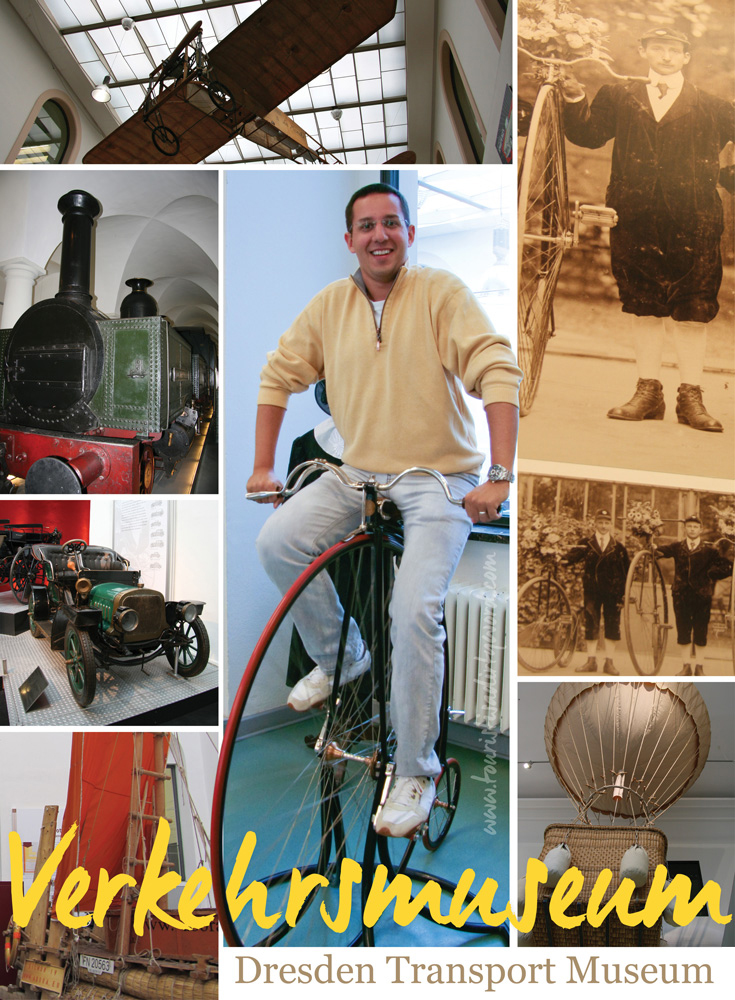
I love museums where you can touch things without getting accosted by the security guards in the room.
It makes the museum come to life and I remember items in that museum for years to come. When I noticed the high-wheel bicycle on the second floor of the Verkehrsmuseum in Dresden, I was elated. It is one of those exhibit experiences that you will not forget! Sitting way higher than normal, imagining how it must have felt like to go down the road on one of these, looking down at people passing you and trying not to lose your balance and land on your face.
But let’s not get carried away and start at the beginning.

The Verkehrsmuseum in Dresden is housed in a building called Johanneum, a 16th-century Renaissance building that was used as a stable for the adjacent Dresden Castle. What better place to put a Transport Museum? I was taken aback when the first two things we saw were a pair of worn out shoes and a sedan chair, when I expected to immediately see cars and trains.
But, before there were cars and trains, this is how people moved around - with the sedan chair being reserved for royalty and very rich folks. That all changed in 1886 when Karl Benz built and patented the motorized tricycle - the first automobile in the world. I had seen pictures of it in one of my fathers car books, but looking at a full size replica in Dresden got me excited to see the rest of the museum. We walked by restored versions of rare classic cars like a Wartburg, several horse carriages and numerous rows with bikes, scooters and motorcycles. The best part? Most of them are not behind glass, you can walk around them and look at all the details without hitting your nose.
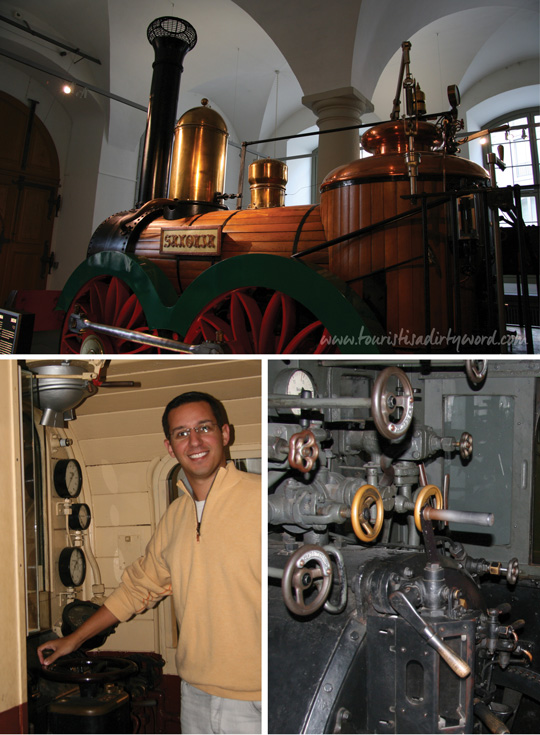
While I am a big automobile fan, I was fascinated by the exhibition next to the cars. There is a huge hall FULL of locomotives and trains, all beautifully restored and, again, not behind glass walls. It is not every day that you get to see the oldest original German steam locomotive called “Muldenthal” from 1861, or a fully furnished saloon carriage. While you cannot step into the saloon carriage rooms, you can jump onto the metal pedestal that they built in front of the carriage windows and take a peek into an era long gone, when Princess Mathilde of Saxony was sitting inside enjoying amenities like gas lights and a private bathroom.
After climbing onto all the platforms and inside a steeple cab, we ventured upstairs into a large play area for children called Verkehrsgarten (traffic garden). Here they can ride on Bobby cars and interact in a shrunken down version of streets and railway crossings tied in with working traffic lights. I would have had such a blast if only I could have fit on one of those cars…
We stroll to the next area full of ship and ocean items including a piece of luggage that catches my eye. It is a gift from a girl that survived the Titanic disaster from 1912. The accompanying story tells us that the suitcase was given to the girl from her father when he placed her in a lifeboat. She had kept the suitcase in memory of her lost father until she passed away and the suitcase was given to the Verkehrsmuseum. I remember standing there and looking at all the stickers on the luggage for several minutes, trying to imagine what it must have been like to be there over 100 years ago. And as much as I daydreamed about it, I forgot to snap a picture of it.
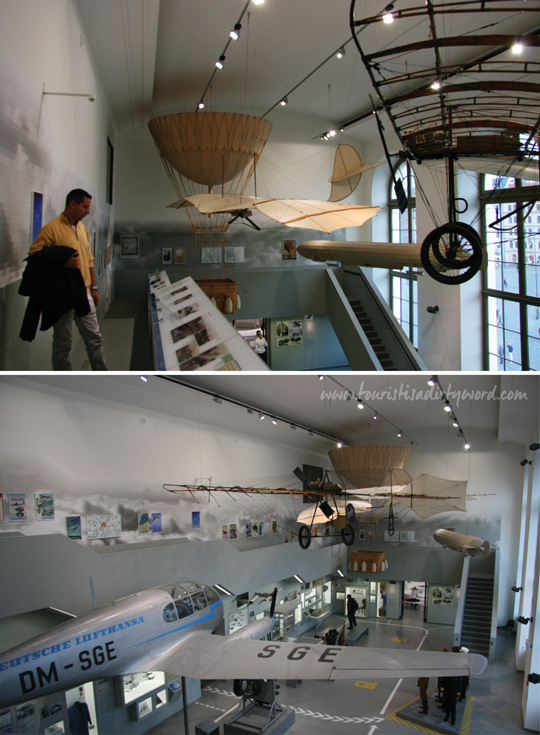
By that time I had lost the rest of my family who already strolled into the plane and flight section, scaring myself walking onto a walkway high up in the air surrounded by a hot air balloon basket and several model planes. My fear of heights did not help with that part of the exhibit and I swiftly made it down the staircase. But even with a fear of heights, I very much enjoyed the last part of the Verkehrsmuseum, looking at the painted details of the model planes and learning more about Graf von Zeppelin and his vision of an airship.
If you go and visit Dresden, do not miss a visit to the Verkehrsmuseum, and snap a picture of that suitcase from the Titanic for me!
Here's a link to the official site for the Verkehrsmuseum.

Germany started with their train system in 1835, when the first steam-engines pulled wagons filled with heavy coal. While there is still a lot of transportation of goods (cars, shipping containers, rocks, etc.) and slow commuter trains, the fastest and easiest way to travel is via high speed train, what we in Germany call ICE (Inter City Express). ICE trains go as fast as 300 km/h, or 186 mph.
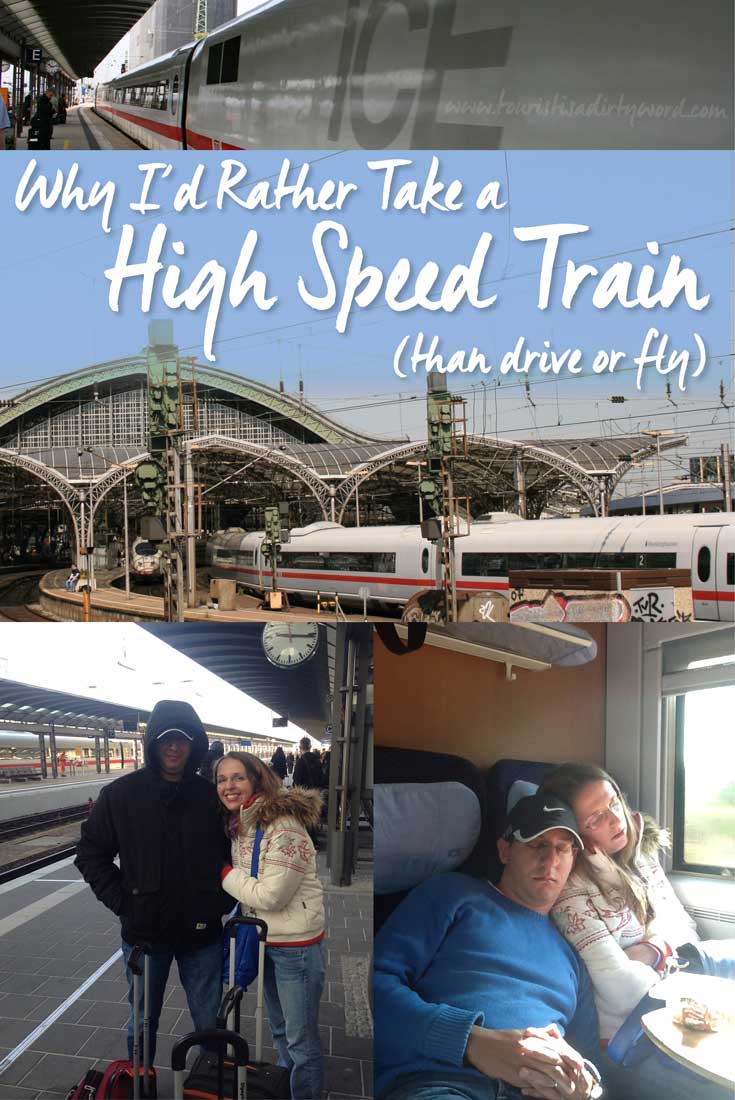
When traveling longer distances within Germany, I prefer taking a train over a car rental or flying. The ICE train from Frankfurt to Berlin, for example takes just four and a half hours. Driving would take roughly five to six hours, depending on traffic. This is the perfect time for you to kick back, read a book, listen to a podcast or just enjoy the scenery you’re zooming by without going through the hassle of driving yourself. Maybe take a nap. It’s that nice. We were traveling with my family on the ICE to Berlin in a ruhebereich, a small, quiet room, and could take a nap without worrying about our belongings.
When Riding the ICE, There’s No Need to Worry About:
• Weighing Your Luggage
• Leaving Your Favorite Liquids Behind
• Finding a Power Outlet (there’s an outlet at every seat on the ICE!)
• Waiting in Security Lines
• How Many Bags and the Size of Bags you Travel with
When the Best Train Ticket Prices are Available
The best way to get your hands on an inexpensive ticket (usually half-off) is to book 70-90 days before your trip on the website of the Deutsche Bahn.
Go straight to the DB English page by clicking here
You can get tickets for 29 € per person usually, but ticket prices go up as the departure date draws near, so plan accordingly and buy early. Simply enter your destination, date and approximate time on the website and you will be given a range of options to choose from.
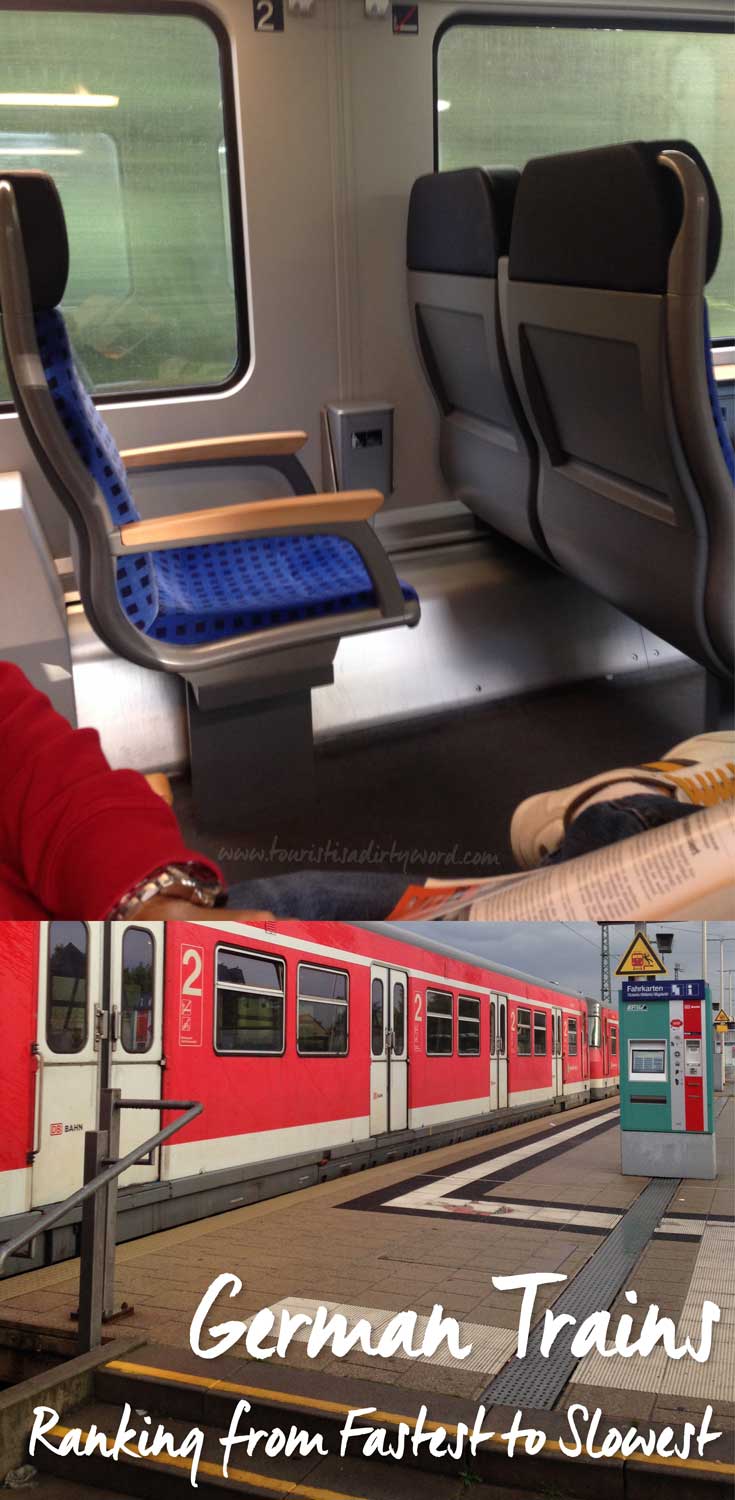
Some connections will be faster, some slower. Here is a ranking from fastest to slowest trains:
• ICE (Inter City Express) usually pronounced ‘Eye See Eee’, are the fastest German trains
• IC (Inter City) trains are a bit slower than ICE trains with a few more stops along the way
• RB (Regional Bahn) and RE (Regional Express) tend to be highly localized with lots of stops. You will see more of the countryside, but travel time can be up to double compared to an ICE train.
Can the Best Travel Option Get Even Better?
Yes, with seat reservations! I highly recommend making a seat reservation on the ICE trains, since those trains can get crowded at rush hour, or if a connection to the same city was canceled. This will cost you about $5 per connection (unless you choose a First Class ticket, where a seat reservation is already included), and trust me, it is worth it and makes for a stress-free travel.
Follow Along
If you enjoyed this article, or these topics sound interesting to you, you'll love our weekly newsletter. You'll receive a free Germany Packing list for signing up, and you'll receive each week's newest posts every Friday. Thank you for reading!

